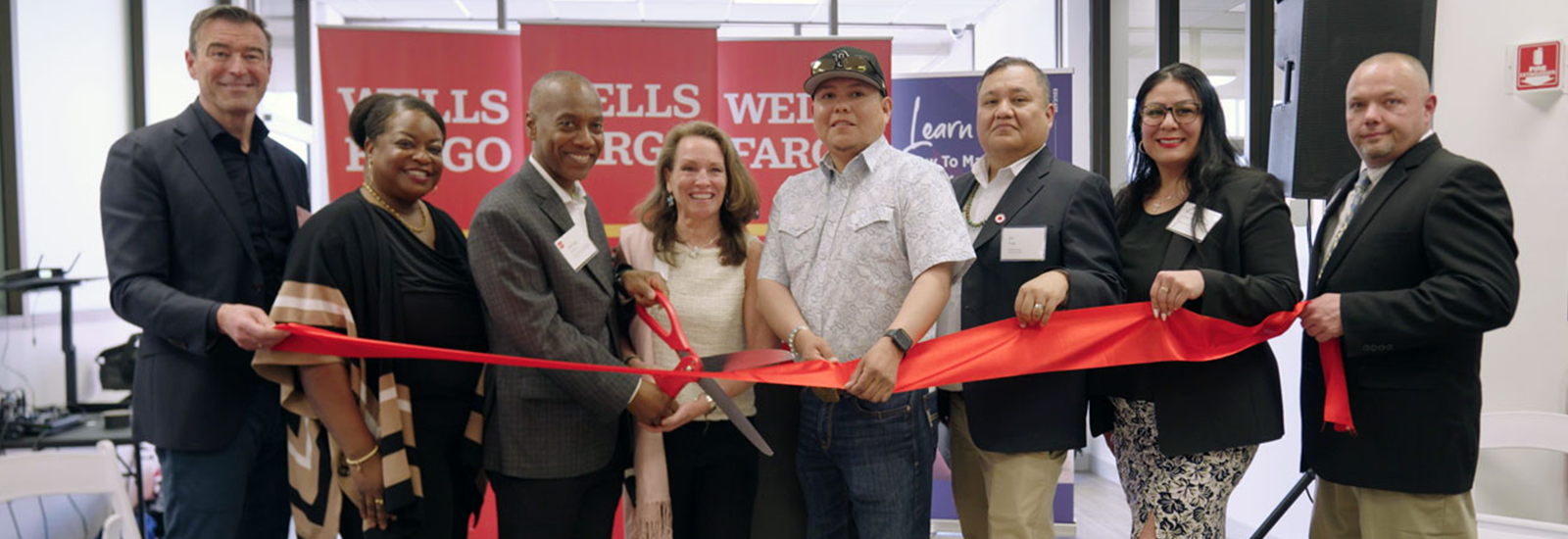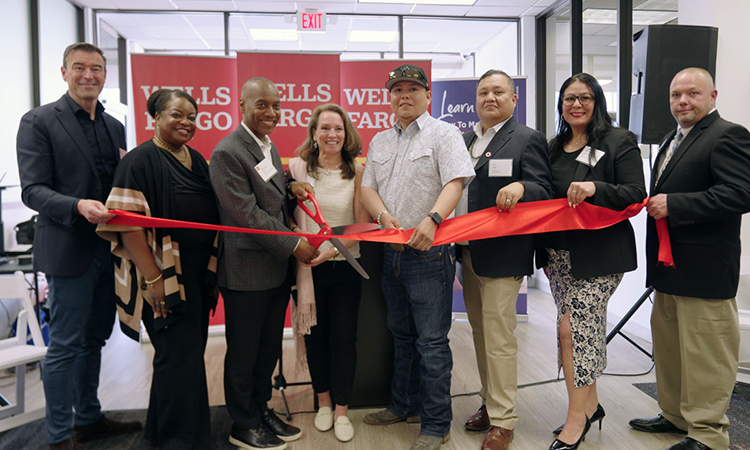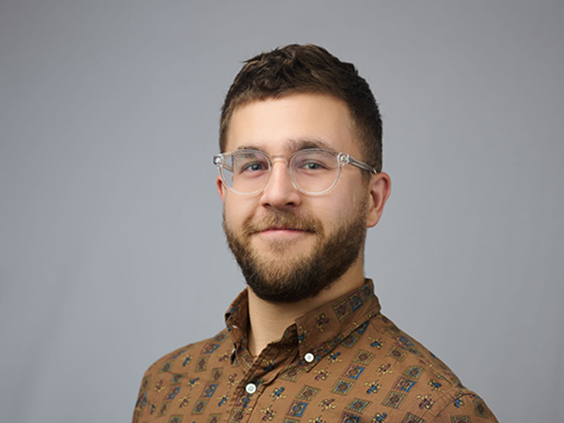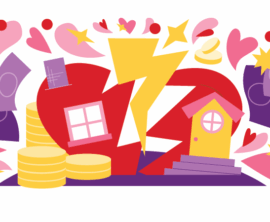[Video overview: Speaking in Navajo, Operation HOPE Inside coach Eli Tully talks about his background and the work he does in helping clients build financial stability.]
[Music]
[On-screen text]
Operation HOPE Inside coach Eli Tully connects with Navajo-speaking clients in their language.
There are times we wonder how money works. Sometimes it affects our well-being and many wonder, ‘How can I fix my credit?’ If you agree, you may stop in and I can help you the best way I can. Please don’t worry yourselves.
Hello. My name is Eli Tully. My clans are, I am Salt Water born for One Who Walks Around. My maternal grandparents are Towering House One Who Walks Around. And my paternal grandparents are Salt People. I am originally from Oak Springs, Arizona, and that is where I was raised.
Recently, I gained the role of a Wellness Coach with Operation HOPE alongside Wells Fargo Bank. My work includes topics of how finances flow, your credit rating, and ways to become creditworthy. I am able to help in various ways. If you would like, come by, come all, and ask for ways you can fix your credit, and I can help you the best way I can. Thank you.
[On-screen text]
©2024 Wells Fargo Bank, N.A. All rights reserved
Operation HOPE Inside coach Eli Tully connects with Navajo-speaking clients in their native language, helping build a financial bridge to the Navajo Nation. (1:53)
Credit: Hector Batista
Key takeaways
- An Operation HOPE financial coach is serving residents of New Mexico, Arizona, and the Navajo Nation in their native languages. Many are unbanked or underbanked.
- This free, one-on-one financial coaching is possible through a HOPE Inside center in Gallup, New Mexico, the first of its kind in the state, located inside of a Wells Fargo branch.
- Millions of unbanked and underbanked households use nonbank financial services, according to the FDIC (PDF). These may come with high fees or interest rates that make it harder for people to accomplish their financial goals.
- Clients of Wells Fargo’s HOPE Inside centers have made proven strides in growing savings, reducing debt, and raising credit scores, according to Operation HOPE data.
Winding single-lane highways connect the corners of the Navajo Nation. Near the country’s largest reservation — bigger than West Virginia — Eli Tully connects communities, too. Each journey through the Southwestern desert to meet a client is a financial bridge where there may not have been one before.
Unbanked: There are approximately 5.6 million U.S. households in which no one has a checking or savings account at a bank or credit union.
Underbanked: About 19 million households in the U.S. are underbanked, which means although their household is banked, they use:
- Nonbank transactions like check cashing services, or
- Credit services like payday lending, pawn shops, or auto title loans
Tully, an Operation HOPE financial coach, primarily helps clients from the first HOPE Inside center in New Mexico. The center, which is in a Wells Fargo branch near the reservation border town of Gallup, New Mexico, is among a growing number of HOPE Inside centers in Wells Fargo branches around the country that provide free, one-on-one financial coaching. Operation HOPE data shows this coaching has empowered people to save money, reduce debt, and increase their credit scores.
“We have some individuals here that are so, so private that they would never walk into a bank,” Tully said. “These people are getting the knowledge now that they weren’t getting 10 or 20 years ago.”
Tully is particularly well-qualified to reach the 5.3% of New Mexicans who were unbanked as of 2023 — just over 1% higher than the national average. The former Wells Fargo employee grew up in the Navajo Nation, spent nearly 10 years in banking and fraud investigation, and then joined Operation HOPE to focus on helping his community. Tully, who speaks Navajo in addition to English, Spanish, and Portuguese, can be identified by his family’s Dine (Navajo) clans: Todik’ozhi-Honaghaahnii-Kinyaa’aanii-Ashiihi.
He understands firsthand that many Indigenous and Native American people grow up with a distrust of the banking system. Historically, Native Americans and Alaska Natives have been more likely than any other demographic to be unbanked, though that has reversed quickly in recent years, according to the FDIC (PDF).
“When I was 18, 19, I didn’t have this kind of coaching. I didn’t have any type of direction on credit cards, building credit, finding a way to get a vehicle — none of that was coached,” Tully said. “I wanted to be that connection for all walks of life in my community.”
He’s already helped some clients with no credit history, including people in their 50s. A 26-year-old client — who never opened a bank account and didn’t understand credit — went from a poor credit score to one in the high 700s.
“He called me and was almost in tears because he understands the credit scoring system now. Before, he thought a credit score of 300 was the best he could have,” Tully said. “I showed him the scale and said, ‘Dude, you’re way up here now.’”
What does it cost to be unbanked?
$40,000
The potential cost of being unbanked due to using high-fee alternative banking products like check-cashing services
$360,000
What that $40,000 could generate if it was invested over 40 years via a low-cost, exchange-traded fund
$365,000
The median home price in New Mexico
How the cost of being unbanked adds up over time
In place of a banking relationship, unbanked Americans may use alternative financial services that may carry risks: higher interest rates, bigger fees, or losing valuable assets like a car. In Gallup, for example, Tully reaches out to payday and auto title loan companies to try and get referrals for clients who could benefit from his coaching.
“This community is really, really bombarded with payday loans,” he said. “They’re fishing. They’re reeling in all these people to take advantage of.”
Relying on services from payday lenders, check cashers, pawn shops, and money transfer services can feel like getting stuck on a treadmill. It’s hard to move forward when you’re paying high fees or interest rates. The Brookings Institution found that an unbanked person could spend as much as $40,000 on check-cashing services over their lifetime.
“People wind up paying those fees over and over and over again,” said Michael Martino, head of Customer Growth Segments for Consumer, Small and Business Banking (CSBB) at Wells Fargo. “[Relying on these alternative banking options] never allows the unbanked person to get ahead and participate in the banking economy.”
For some, these nonbank or costly alternative financial services may act more like daily money managers rather than long-term wealth builders. Martino said it gets worse when unbanked households don’t have a mainstream banking relationship and miss out on three keys to creating multigenerational wealth:
- Credit access through credit cards and loans
- Earned interest and returns via savings and investment products
- An education on how the financial system works
So, why are people unbanked? The most-cited reasons are the costs of banking, unpredictable or unexpected fees, and issues reaching minimum banking requirements, according to the most recent 2023 FDIC survey data (PDF).
On the Navajo Nation, accessibility to high-quality banking services — and necessities like electricity and groceries — has been an issue.
“Our community is considered unbanked and underbanked because we’re always a community that is forgotten or last, and that’s true across the board,” Tully said.
[Video overview: Eli Tully, Operation HOPE Inside Coach; Mary Ehrsam, EVP, President of Operation HOPE Partnerships; Saul Van Beurden, CEO of Consumer, Smal & Business Banking; and Laura Montoya, New Mexico State Treasurer talk about the launch of a HOPE Inside Center in New Mexico.]
[Music]
[Eli Tully, Operation HOPE Inside Coach]
It’s a monumental moment for me because I’m in my own community, and I’m helping my community build financial stability.
[A group of people cheer while cutting a large red ribbon to symbolize the grand opening.]
[Mary Ehrsam, EVP, President of Operation HOPE Partnerships]
Operation HOPE’s first office and first launch of a partnership in New Mexico is incredible.
[Saul Van Beurden, CEO of Consumer, Small & Business Banking]
If you have access to the bank and you need help or you start to get in financial distress, we are there to help you and we are there with the HOPE Centers to help you.
[Laura Montoya, New Mexico State Treasurer]
I am very grateful for all of you for participating in this.
[Tully]
I feel like it’s very important because financial stability, financial literacy is the backbone of success.
[On-screen text]
©2024 Wells Fargo Bank, N.A. All rights reserved.
Representatives from Wells Fargo and Operation HOPE were on-hand in Gallup, New Mexico, to celebrate the opening of the first HOPE Inside center in the state. (0:40)
Credit: Hector Batista
How HOPE Inside clients are improving their finances:
- 65% increased their credit score by an average of 30 points.
- 75% increased their savings by an average of $475.
- 44% decreased their debt by an average of $1,700.
Source: Operation HOPE data as of June 2025.
How HOPE Inside centers help unbanked and underbanked clients
When Tully sits down with a client for the first time, he checks to see if they’re from the same community. It’s possible they may be related. Even if they’re not, it creates a community-level relationship.
“I say, ‘Oh, you’re from the next community to mine?’ Most likely, they know my grandparents. I create the relation. I create the trust,” he said.
Coaching offered through HOPE Inside centers focuses on financial goals like improving your credit score, boosting savings, or building a budget. The coaching is free, and clients have no obligation to bank with Wells Fargo. By working with coaches like Tully, clients build a path toward reaching their financial goals.
“The most important thing is what happens next. Once you can achieve [financial stability], can you buy a home? Can you start a business? Can you achieve a better auto loan? Can you put your kids through college?” said Mary Ehrsam, Operation HOPE’s president of partnerships. “That’s what we’re here for.”
Wells Fargo serves one in three of the country’s 574 federally recognized tribes, and its work with Navajo Nation goes back more than six decades. In fact, there are five branches throughout the reservation.
“Our roots are in the West. And what that means is our leaders have experience working in Indian Country. They’ve met tribal leaders, and they’ve been to reservations,” said Dawson Her Many Horses, Managing Director and Customer Growth Segment Leader at Wells Fargo.
Wells Fargo continues to invest in HOPE Inside centers to help more communities as part of the Banking Inclusion Initiative. In 2024, 30 centers served more than 11,000 clients. Wells Fargo aims to have 50 centers inside branches throughout the U.S by the end of 2026.
“At the end of the day, we’re empowering people to be able to take control of their financial future,” Martino said. “And that’s multigenerational, because they can teach their children and their families, too.”






